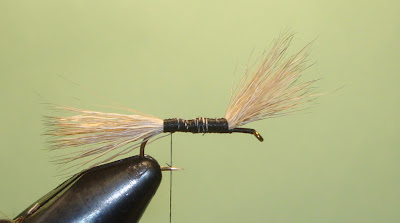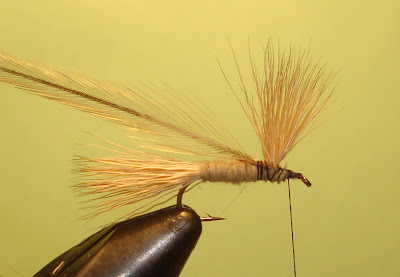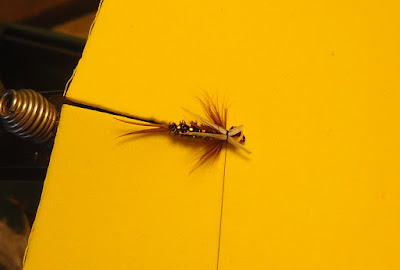Blonde Wulff Tute
There
are many Wulff patterns using different material. This particular one
uses light Elk hair for the tail and wing. A similar pattern, using
white calf tail, is used to create the White Wulff. These patterns
are excellent dry flies for rough water conditions. The White Wulff
is also an excellent pattern to use for a coffin fly on a 3x long
hook.
Blonde
Wulff
Hook:
Dry Fly 2x long #8 to #14
Thread:
Black
Tail:
Light Elk hair
Wing:
Light Elk hair
Body:
Buff tan dry fly dubbing
Hackle: Med. tan hackle
1.
After thread basing the hook shank tie in a tail about the length of
the hook length. (From behind eye to end of bend) Trim the ends about
a third the way forward from the bend. I like to keep it trimmed at a
taper as shown.
2.
Wing: Tie down a wing of light elk hair about a third the way back
from the hook eye. The length of wing will be the same as the length
of the tail. Make a few wraps of thread in front of wing to draw it
upward but no need to get it exactly perpendicular to the hook shank
just yet.
3. Trim
the butt ends of the wing hair just over the tapered butt hair of the
tail and thread wrap back to bend of hook.
4.
Body: Dub a body of buff tan fur. Make a few fur wraps in front of
the wing to stand up straight and bring thread back behind wing.
5.
Hackle: Tie in hackle behind wing as shown with dominate color facing
you. The length of hackle is the same length of the hook shank. (From
behind eye to start of bend)
6: Wrap
hackle around dubbing forward behind and in front of wing. Make more
wraps behind wing than in front.
7. Trim
ends of hackle and you can whip finish or I like to use a half hitch
tool and make at least 2 half hitches for thread head.
8.
Blonde Wulff. Dab head cement on thread head and you’re ready to
fish it.
~doubletaper






























